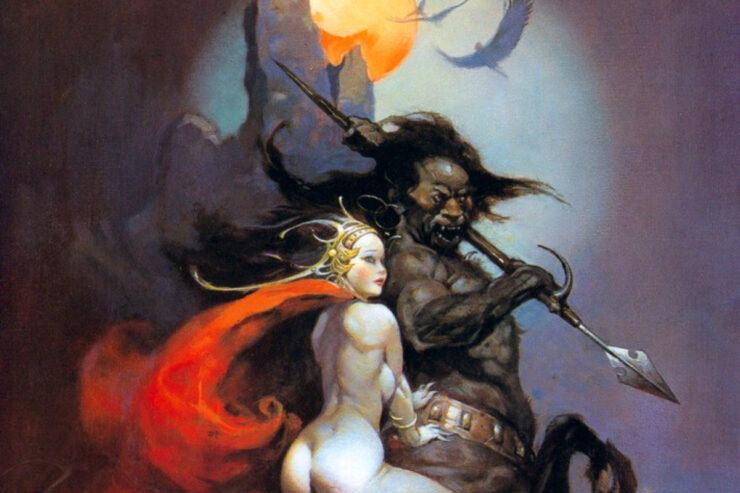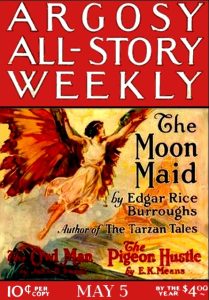
At PulpFest 2023, we’ll not only be celebrating the centennials of Weird Tales and Sport Story Magazine but also the 100th anniversary of Edgar Rice Burroughs’ “Moon Trilogy.” It’s part of the second ERBFest that we’re planning for our 2023 PulpFest.
In his seminal work, Edgar Rice Burroughs: Master of Adventure, author Richard A. Lupoff called the “Moon Trilogy,” “Burroughs’ masterpiece of science fiction and a too-often overlooked pioneer work of the modern school of social extrapolation in science fiction.”
Although the trilogy debuted to the reading public with the serialization of “The Moon Maid” in Munsey’s Argosy All-Story Weekly in 1923, Edgar Rice Burroughs had actually started writing the series four years earlier with a tale he entitled “Under the Red Flag.” It was the author’s response to the October Revolution of 1917 and the anarchist movement in the United States.
In a December 1918 letter asking for information about Bolshevism and the International Workers of the World movement in the United States, Edgar Rice Burroughs described his story:
I have in mind a novel of the future showing conditions one or two hundred years from now, presupposing a world-wide adoption of Bolshevikism. It is not my expectation to write anything that will revolutionize public opinion as my stories are for primarily entertainment, but if I could obtain information . . . which would permit me to write more intelligently on the aims and practices of these parties, it might be that my story would be of value in setting people to thinking of the results of which must follow the continued dissemination of this type of propaganda.
Completing his tale on May 21, 1919, Burroughs submitted “Under the Red Flag” to All-Story Weekly, Cosmopolitan, Red Book, The Saturday Evening Post, and other magazines. For various reasons, it was rejected nearly a dozen times. Ray Long, the editor of Cosmopolitan, found the story to be implausible. Bob Davis of All-Story felt it was bad business for a fiction magazine to stir the pot. Dismissing such rejections, Burroughs promised to see his story in print, “even if I have to publish it at my own expense.” It would take him six years to fulfill his pledge.
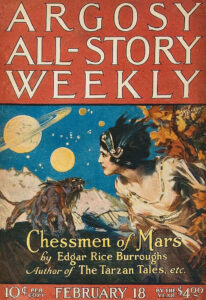 Unable to place “Under the Red Flag,” Burroughs turned to other work. “The Efficiency Expert,” “Tarzan the Terrible,” “The Chessmen of Mars,” “The Penningtons” (published as “The Girl from Hollywood”), and “Tarzan and the Golden Lion,” all found a home with the Munsey chain of magazines. Next in line was “The Moon Maid,” serialized in Argosy All-Story Weekly from May 5 through June 2, 1923.
Unable to place “Under the Red Flag,” Burroughs turned to other work. “The Efficiency Expert,” “Tarzan the Terrible,” “The Chessmen of Mars,” “The Penningtons” (published as “The Girl from Hollywood”), and “Tarzan and the Golden Lion,” all found a home with the Munsey chain of magazines. Next in line was “The Moon Maid,” serialized in Argosy All-Story Weekly from May 5 through June 2, 1923.
Employing the scientific romance genre that he had used to great effect in “Under the Moons of Mars,” “The Gods of Mars,” “At the Earth’s Core,” and other novels, “The Moon Maid” is the story of Julian 5th, commander of the first Earth voyage to Mars. Among his crew is Lieutenant Commander Orthis, a scientific genius who is insanely jealous of Julian. In a drunken rage, Orthis sabotages the space vessel, forcing it to land inside of the Moon.
Like the protagonists of H. G. Wells’ The First Men in the Moon, Burroughs’ characters discover a world hidden under the lunar surface. Earth’s satellite is populated by the Va-gas, a race of cannibals that somewhat resemble mythological centaurs; the U-gas, a significantly more advanced humanoid species; and the cruel and sadistic Kalkars, who lead a decadent existence under communism. While the diabolic Orthis falls in with the latter, Julian 5th joins with the U-gas, falling in love with Nah-ee-lah, the “Moon Maid” of the story’s title.
Although very much a part of the same school of writing as Burroughs’ Martian and Inner Earth tales, “The Moon Maid” is one of his more downbeat works. The novel ends with the Kalkars overrunning the remaining U-gas in the great lunar city of Laythe.
And then I saw a warrior . . . leap upon the surrounding wall that bordered . . . the edge of the yawning, bottomless crater. . . . and then wheeling, threw his arms above his head and leaped outward into the yawning, bottomless abyss. . . . The thing spread slowly at first, and then with the rapidity of a prairie fire, it ran around the entire circle of the city. Women hurled their children in and then leaped after them. The multitude fought one with another for a place upon the wall from which they might cast themselves to death.
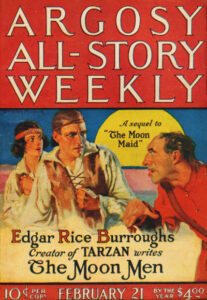 Julian and his “Moon Maid” are able to escape the terrible cataclysm and return to Earth. Two years later, their story continues in “The Moon Men,” a revised version of Burroughs’ unpublished anti-Bolshevik diatribe, “Under the Red Flag.” The author had chosen wisely by softening up his audience with the scientific romance that is “The Moon Maid,” allowing him to finally see his vow fulfilled.
Julian and his “Moon Maid” are able to escape the terrible cataclysm and return to Earth. Two years later, their story continues in “The Moon Men,” a revised version of Burroughs’ unpublished anti-Bolshevik diatribe, “Under the Red Flag.” The author had chosen wisely by softening up his audience with the scientific romance that is “The Moon Maid,” allowing him to finally see his vow fulfilled.
Replacing Bolsheviks with the Kalkars, “The Moon Men” was serialized in Argosy All-Story Weekly from February 21 through March 14, 1925. The story takes place during the 22nd century. Thanks to the advanced weaponry of the evil Orthis, the Kalkars have conquered the Earth.
The second part of Burroughs’ “Moon Trilogy” tells the tale of Julian 9th, who grows up near the ruins of Chicago. Julian and his family raise goats near the stilled metropolis in a collectivized, agrarian America ruled with an iron fist by the Kalkars. Those who collaborate with their alien overlords are rewarded, while those who resist are sentenced to the mines and death.
An oppressively dystopian tale, “The Moon Men” ends with an unsuccessful revolt against the ruling Kalkars. Julian 9th, the leader of the rebellion, is captured and handed over to “The Butcher” for execution.
I recall every detail up until the moment the knife touched my throat — there was a slight stinging sensation followed instantly by — oblivion.
Richard Lupoff calls “The Moon Men” the best segment of the trilogy. “Burroughs’ obvious deep feelings about communism, his revulsion at its tyranny and terror in the names of justice and brotherhood, is a powerful force in making “The Moon Men” an outstanding example of that form of imaginative literature dubbed ‘social science fiction.'”
 Edgar Rice Burroughs concluded his “Moon Trilogy” with “The Red Hawk,” serialized in Argosy All-Story Weekly from September 5 through September 19, 1925.
Edgar Rice Burroughs concluded his “Moon Trilogy” with “The Red Hawk,” serialized in Argosy All-Story Weekly from September 5 through September 19, 1925.
Set during the 25th century, “The Red Hawk” is the story of Julian 20th, who is known as the Red Hawk. The chief of 100 clans of “Yanks” or “Americans,” Julian leads 25,000 warriors against the hated Kalkars, promising to drive the enemy into the great sea to the west.
With the action taking place around a crumbling Los Angeles and the hills and valleys surrounding the California city, “The Red Hawk” is a war story. It ends with Julian and his people making peace with the descendants of the traitorous Orthis and finally evicting the Kalkars from the former United States of America. “The Red Hawk” is, by far, the most uplifting segment of the trilogy, a mix of the scientific romance of “The Moon Maid” and the dystopian visions found in “The Moon Men.” It is a fitting conclusion to Edgar Rice Burroughs’ “Moon Trilogy,” 100 years old this month.
We hope you’ll join us August 3 – 6 for PulpFest 2023 and ERBFest 2023, appropriately taking place in Mars, Pennsylvania. We’ll not only be saluting the 100th anniversary of Burroughs’ “Moon Trilogy,” but also the centennial of Edgar Rice Burroughs, Inc. and the 150th anniversary of artist J. Allen St. John’s birth. In addition to our planned programming presentations, Henry G. Franke III — the editor of The Burroughs Bulletin — will be hosting an art show and a late-night bull session. They’re all part of our latest celebration of the Master of Adventure, ERBFest 2023.
You can join both conventions (as well as FarmerCon XVIII) by clicking our registration button at the top of our homepage. The conventions will be held at the DoubleTree by Hilton Hotel Pittsburgh – Cranberry in Mars, Pennsylvania.
To reserve a room at the DoubleTree, click the “Book a Room” button or call 1.866.568.0896. Be sure to mention PulpFest to get the special convention rate. By staying at the DoubleTree, you’ll help to ensure the convention’s success. We urge every member to book a hotel room for PulpFest 2023 and ERBFest 2023 as soon as possible.
Since its first publication in Argosy All-Story Weekly in 1923, Edgar Rice Burroughs’ The Moon Maid has been reprinted many times. Our featured image is Frank Frazetta’s cover art for the Ace Books edition, published in 1974. Heading our post is P. J. Monahan’s cover for the first installment of the story, as published in the May 5, 1923 number of Munsey’s Argosy All-Story Weekly. Monahan also painted the cover art for Argosy All-Story Weekly for February 18, 1922, illustrating Edgar Rice Burroughs’ “Chessmen of Mars.”
The serialization of “The Moon Men” began in the February 2, 1925 issue of Argosy All-Story Weekly, featuring cover art by Stockton Mulford. The conclusion of the trilogy, “The Red Hawk,” began in Argosy All-Story Weekly for September 5, 1925, with cover art by Modest Stein.
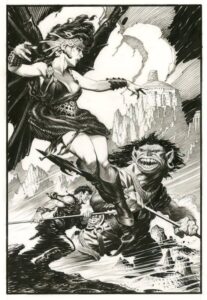 A new edition of Burroughs’ “Moon Trilogy” is forthcoming from ERB Books. By special arrangement with the publisher, PulpFest fans and attendees can get $20 off The Centennial Edition of Burroughs’ “Moon Trilogy.” When placing your order, add coupon code CHOMKO20 to your shopping cart to get the discount.
A new edition of Burroughs’ “Moon Trilogy” is forthcoming from ERB Books. By special arrangement with the publisher, PulpFest fans and attendees can get $20 off The Centennial Edition of Burroughs’ “Moon Trilogy.” When placing your order, add coupon code CHOMKO20 to your shopping cart to get the discount.
You can also use this coupon on At the Earth’s Core, Tarzan of the Apes, and the Standard Edition or the Deluxe Leather Edition of Robert B. Zeuschner’s Edgar Rice Burroughs: The Bibliography. Order all five books and save $100!
The ERB Books “Moon Trilogy” will feature a total of 100 illustrations from over 20 different artists past and present and contain 20+ tipped-in color plates, 30+ full-page black and white illustrations, and 40+ spot black and white illustrations. Included among the illustrations will be “Pulp Selene,” drawn by PulpFest 2023 guest artist Mark Schultz.
For more on Edgar Rice Burroughs’ “Moon Trilogy,” please visit the PulpFest YouTube Channel and check out Craig McDonald’s video “Moon Maid Celebrates 100th Anniversary at PulpFest 2023.” You’ll find it at https://youtu.be/Pxofa-mnhq0. While you’re there, please be sure to subscribe to our channel and be the first person under the Moon to see each video. Don’t forget your green cheese.
Leslie Silberberg is a writer and popular culture enthusiast who began posting on our website in 2022. She enjoys the science fiction pulps, particularly the work of such leading female writers as Leigh Brackett, Claire Winger Harris, Zenna Henderson, Judith Merril, C. L. Moore, Margaret St. Clair, Wilmar H. Shiras, Francis Stevens, and Leslie F. Stone. Many thanks to Ms. Silberberg for her contributions to pulpfest.com.
Trademarks The Moon Maid™, The Moon Men™, Edgar Rice Burroughs®, and others owned by Edgar Rice Burroughs, Inc. Associated logos, characters, names, and the distinctive likenesses thereof are trademarks or registered trademarks of Edgar Rice Burroughs, Inc. Used by Permission.

